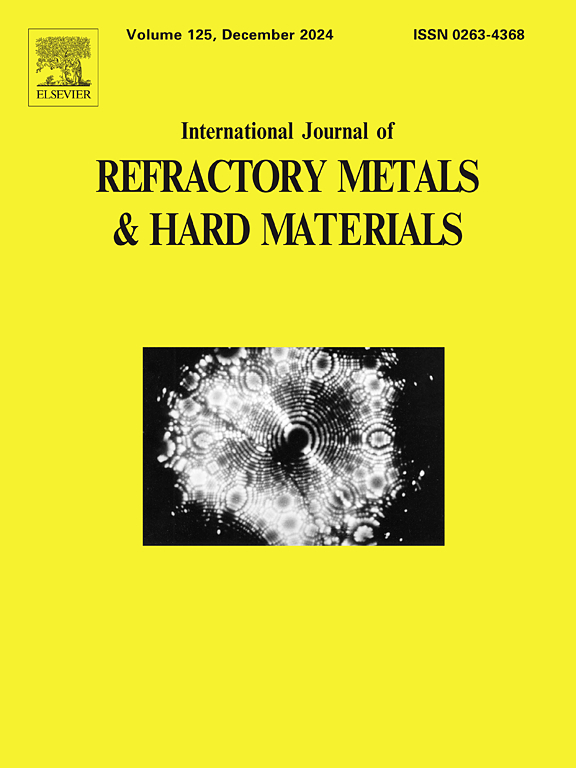Fabrication of wear-resistant diamond/Ni-based composite coatings via induction brazing
IF 4.2
2区 材料科学
Q2 MATERIALS SCIENCE, MULTIDISCIPLINARY
International Journal of Refractory Metals & Hard Materials
Pub Date : 2025-02-20
DOI:10.1016/j.ijrmhm.2025.107098
引用次数: 0
Abstract
Recently, the preparation of diamond-metal composite coatings has garnered significant attention from researchers. This paper presents a brazing process for diamond‑nickel-based composite coatings. The effects of brazing temperature and holding time on the microstructure and mechanical properties of the coating were investigated. The results indicate that the diamond‑nickel-based composite coating is defect-free and demonstrates excellent wear resistance under optimal parameters. The composite coating primarily consists of diamond, γ-Ni, Cr2C3, and M7C3,other phases such as Ni3C, Fe![]() Ni, etc. may also be present. As brazing temperature and holding time increase, the diffusion layer between the coating and steel substrate thickens, the microstructure of the brazing alloy coarsens, and cracks eventually form. At a brazing temperature of 1050 °C and a holding time of 15 s, the average wear mass loss of the coating was just 166.3 mg, indicating excellent abrasive wear resistance.
Ni, etc. may also be present. As brazing temperature and holding time increase, the diffusion layer between the coating and steel substrate thickens, the microstructure of the brazing alloy coarsens, and cracks eventually form. At a brazing temperature of 1050 °C and a holding time of 15 s, the average wear mass loss of the coating was just 166.3 mg, indicating excellent abrasive wear resistance.
感应钎焊法制备耐磨金刚石/镍基复合涂层
近年来,金刚石-金属复合涂层的制备受到了研究人员的广泛关注。本文介绍了一种金刚石-镍基复合镀层的钎焊工艺。研究了钎焊温度和保温时间对镀层组织和力学性能的影响。结果表明,在最佳参数下,金刚石-镍基复合涂层无缺陷,具有良好的耐磨性。复合镀层主要由金刚石、γ-Ni、Cr2C3和M7C3组成,也可能存在Ni3C、FeNi等相。随着钎焊温度和保温时间的增加,涂层与钢基体之间的扩散层变厚,钎焊合金的显微组织变粗,最终形成裂纹。当钎焊温度为1050℃,保温时间为15 s时,镀层的平均磨损质量损失仅为166.3 mg,具有良好的磨粒耐磨性。
本文章由计算机程序翻译,如有差异,请以英文原文为准。
求助全文
约1分钟内获得全文
求助全文
来源期刊
CiteScore
7.00
自引率
13.90%
发文量
236
审稿时长
35 days
期刊介绍:
The International Journal of Refractory Metals and Hard Materials (IJRMHM) publishes original research articles concerned with all aspects of refractory metals and hard materials. Refractory metals are defined as metals with melting points higher than 1800 °C. These are tungsten, molybdenum, chromium, tantalum, niobium, hafnium, and rhenium, as well as many compounds and alloys based thereupon. Hard materials that are included in the scope of this journal are defined as materials with hardness values higher than 1000 kg/mm2, primarily intended for applications as manufacturing tools or wear resistant components in mechanical systems. Thus they encompass carbides, nitrides and borides of metals, and related compounds. A special focus of this journal is put on the family of hardmetals, which is also known as cemented tungsten carbide, and cermets which are based on titanium carbide and carbonitrides with or without a metal binder. Ceramics and superhard materials including diamond and cubic boron nitride may also be accepted provided the subject material is presented as hard materials as defined above.

 求助内容:
求助内容: 应助结果提醒方式:
应助结果提醒方式:


